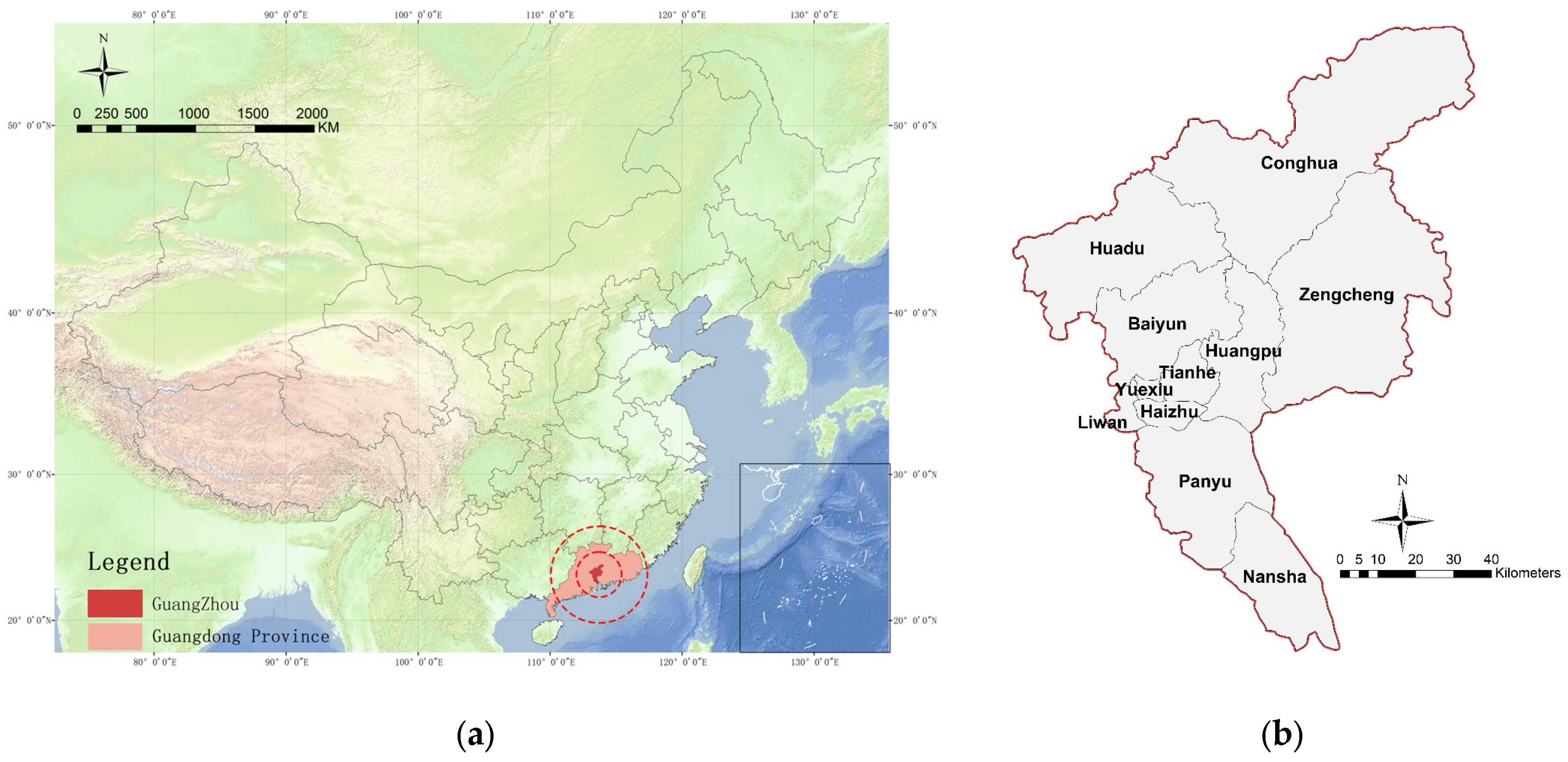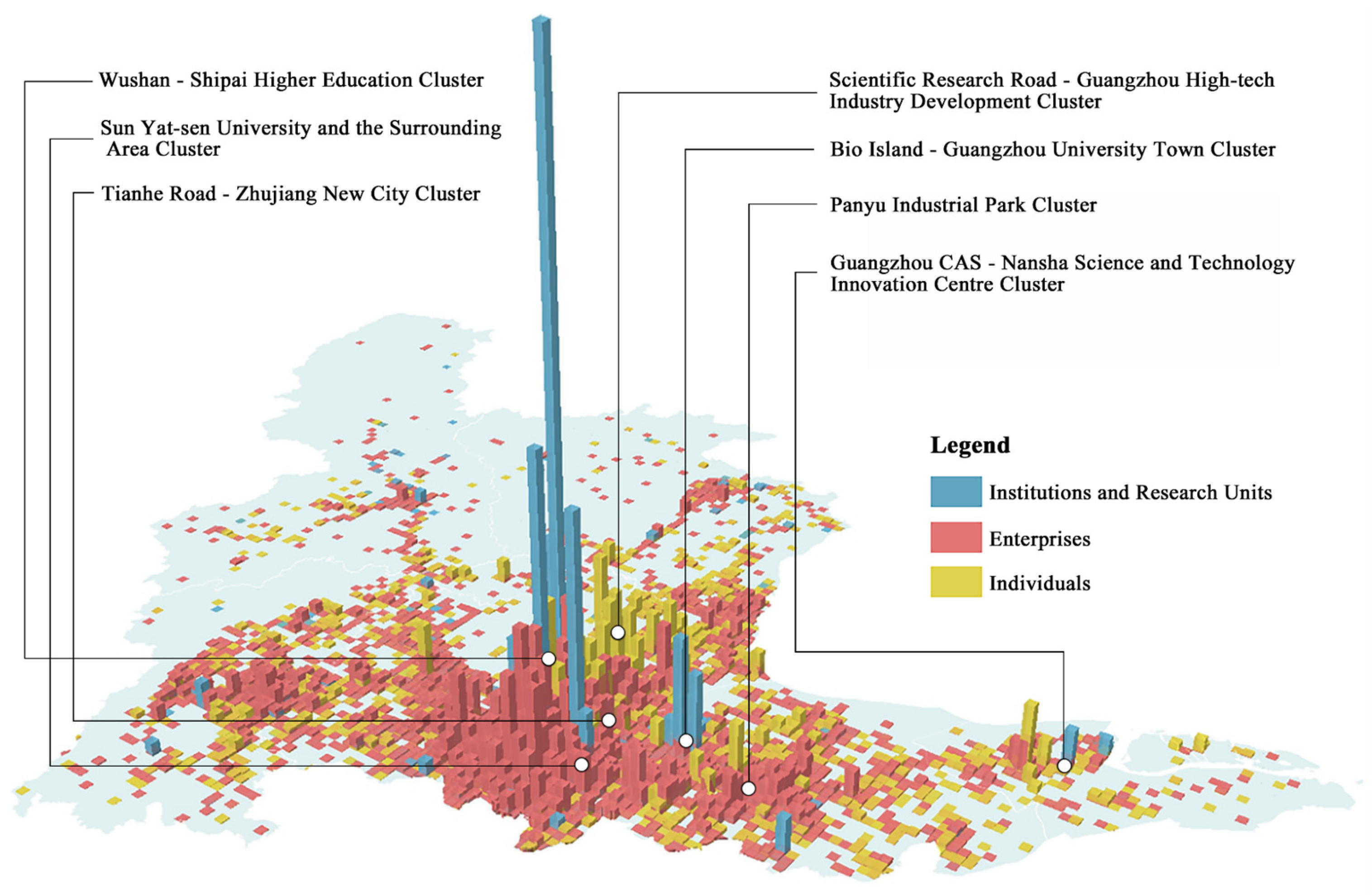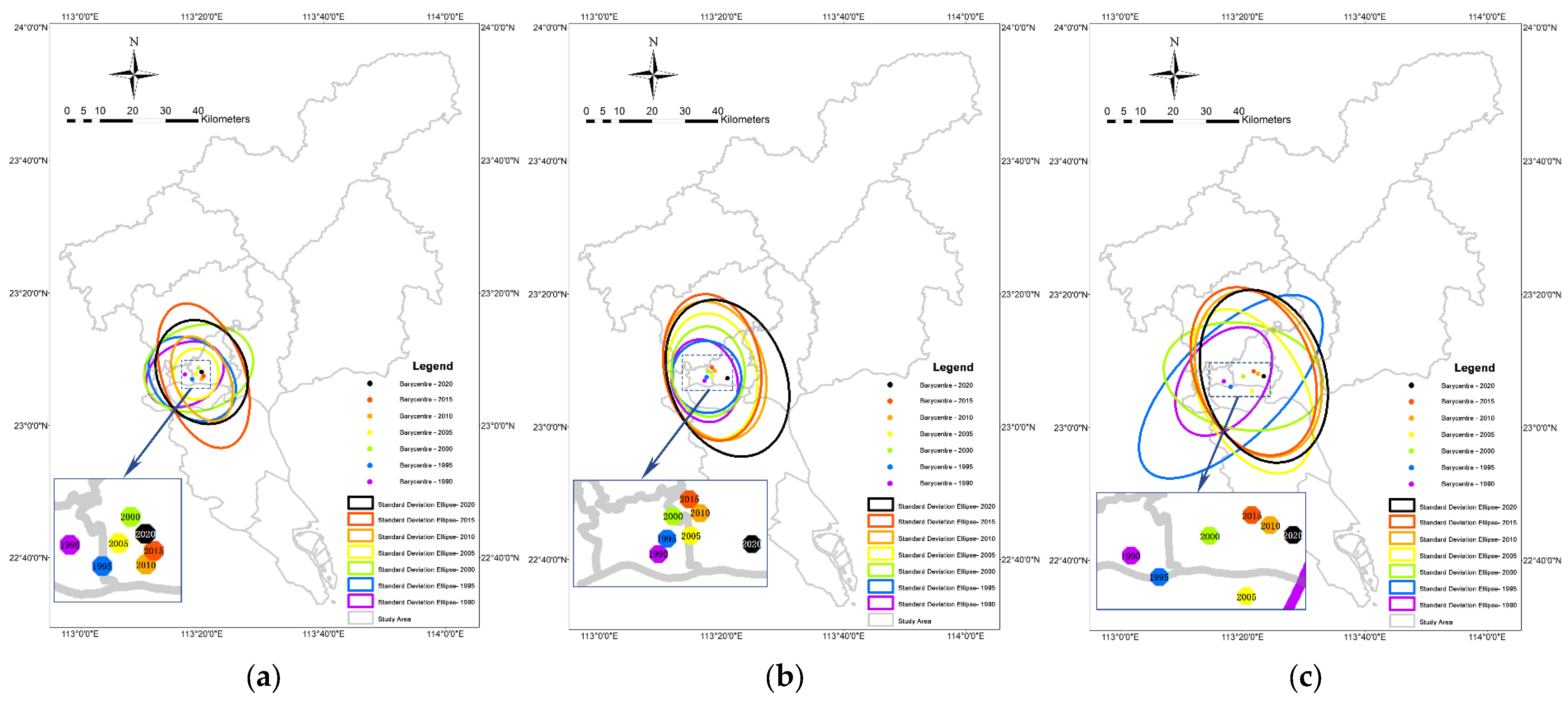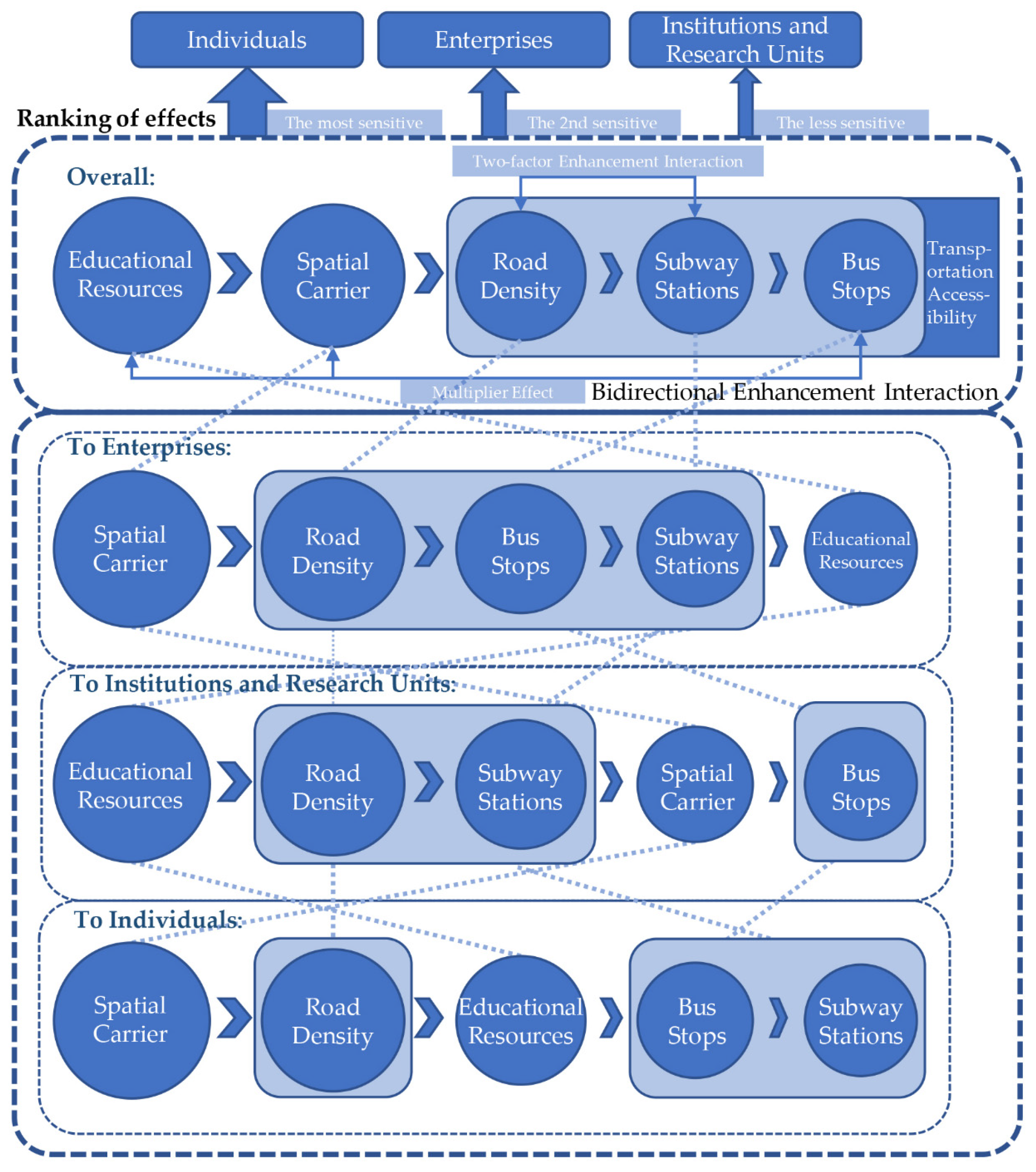The Spatial Pattern Evolution of Urban Innovation Actors and the Planning Response to Path Dependency: A Case Study of Guangzhou City, China
Abstract
:1. Introduction
2. Materials and Methods
2.1. Study Area
2.2. Data Source
2.3. Research Methods
2.3.1. ArcGIS Spatial Analysis
Kernel Density Analysis
Hotspot Analysis
Standard Deviation Ellipse Definition
Exploratory Spatial Data Analysis
2.3.2. Statistics of the Spatial Gini Coefficient
2.3.3. The Geographical Detector Model
2.3.4. Research Process
3. Results
3.1. Innovation Space Distribution Characteristics
3.2. Spatial–Temporal Evolution of Innovation Spaces
3.3. Temporal Evolution of the Spatial Correlation
3.4. Path Dependence Research on Urban Innovation Spaces, Actors, and Behavioral Needs in Guangzhou City
3.4.1. Influencing Factors
- Transportation accessibility
- 2.
- Educational resources
- 3.
- Spatial carriers
3.4.2. Path Dependence Research
4. Discussion
5. Conclusions
Author Contributions
Funding
Data Availability Statement
Conflicts of Interest
References
- Feldman, M.P. The Geography of Innovation; Springer Science & Business Media: Berlin/Heidelberg, Germany, 1994; Volume 2, ISBN 0-7923-2698-9. [Google Scholar]
- Du, D. Glocal S&E Innovation Centre: Motivation and Model Shanghai; Shanghai People’s Publishing House: Shanghai, China, 2015; ISBN 978-7-208-12794-4. [Google Scholar]
- Mendoza-Silva, A. Innovation Capability: A Systematic Literature Review. Eur. J. Innov. Manag. 2021, 24, 707–734. [Google Scholar] [CrossRef]
- Lachang, L.; Ru, H.; Qian, L. Several Theoretical Issues on Innovation Geography. Sci. Geogr. Sin. 2016, 36, 653–661. (In Chinese) [Google Scholar]
- Florida, R. The Rise of the Creative Class–Revisited: Revised and Expanded; Basic Books (AZ): New York, NY, USA, 2014; ISBN 0-465-04248-1. [Google Scholar]
- Drivas, K.; Economidou, C.; Karkalakos, S.; Tsionas, E.G. Mobility of Knowledge and Local Innovation Activity. Eur. Econ. Rev. 2016, 85, 39–61. [Google Scholar] [CrossRef]
- Qiao, Y.; Ding, C.; Liu, J. Localization, Knowledge Spillover, and R&D Investment: Evidence of Chinese Cities. J. Urban Manag. 2019, 8, 303–315. [Google Scholar]
- Drivas, K.; Economidou, C.; Karamanis, D.; Sanders, M. Mobility of Highly Skilled Individuals and Local Innovation Activity. Technol. Forecast. Soc. Chang. 2020, 158, 120144. [Google Scholar] [CrossRef]
- Wang, J.; Liu, N.; Ruan, Y. Influence Factors of Spatial Distribution of Urban Innovation Activities Based on Ensemble Learning: A Case Study in Hangzhou, China. Sustainability 2020, 12, 1016. [Google Scholar] [CrossRef]
- Brown, P.; Bocken, N.; Balkenende, R. Why Do Companies Pursue Collaborative Circular Oriented Innovation? Sustainability 2019, 11, 635. [Google Scholar] [CrossRef]
- Lima, V.A.; Da Silva Müller, C.A. Why Do Small Businesses Innovate? Relevant Factors of Innovation in Businesses Participating in the Local Innovation Agents Program in Rondônia (Amazon, Brazil). RAI Rev. Adm. Inovação 2017, 14, 290–300. [Google Scholar] [CrossRef]
- Liefner, I.; Brömer, C.; Zeng, G. Knowledge Absorption of Optical Technology Companies in Shanghai, Pudong: Successes, Barriers and Structural Impediments. Appl. Geogr. 2012, 32, 171–184. [Google Scholar] [CrossRef]
- Stejskal, J.; Mikušová Meričková, B.; Prokop, V. The Cooperation between Enterprises: Significant Part of the Innovation Process: A Case Study of the Czech Machinery Industry. Bus. Adm. Manag. 2016, 19, 110–122. [Google Scholar] [CrossRef]
- Duan, D.Z.; Du, D.B.; Chen, Y.; Zhai, Q.H. Spatial-Temporal Complexity and Growth Mechanism of City Innovation Network in China. Sci. Geogr. Sin. 2018, 38, 1759–1768. (In Chinese) [Google Scholar]
- Zhou, C.; Zeng, G.; Shang, Y. Progress and Prospect of Research on Innovation Networks: A Perspective from Evolutionary Economic Geography. Econ. Geogr. 2019, 39, 27–36. (In Chinese) [Google Scholar]
- Liu, N.; Wang, J.; Song, Y. Organization Mechanisms and Spatial Characteristics of Urban Collaborative Innovation Networks: A Case Study in Hangzhou, China. Sustainability 2019, 11, 5988. [Google Scholar] [CrossRef]
- Hernández-Trasobares, A.; Murillo-Luna, J.L. The Effect of Triple Helix Cooperation on Business Innovation: The Case of Spain. Technol. Forecast. Soc. Chang. 2020, 161, 120296. [Google Scholar] [CrossRef]
- Feng, Z.; Cai, H.; Chen, Z.; Zhou, W. Influence of an Interurban Innovation Network on the Innovation Capacity of China: A Multiplex Network Perspective. Technol. Forecast. Soc. Chang. 2022, 180, 121651. [Google Scholar] [CrossRef]
- Zhao, W.; Zhu, C.; Zhu, Y. The Comparative Advantage of Cities and Innovation Value Chain: Evidence from China. Sustainability 2022, 14, 3510. [Google Scholar] [CrossRef]
- Anttonen, M.; Lammi, M.; Mykkänen, J.; Repo, P. Circular Economy in the Triple Helix of Innovation Systems. Sustainability 2018, 10, 2646. [Google Scholar] [CrossRef]
- Wang, Y.; Liu, Z. Research on the Regional Cooperation Innovation Network of Universities in the Guangdong–Hong Kong–Macao Great Bay Area. Sustainability 2023, 15, 9838. [Google Scholar] [CrossRef]
- Acs, Z.J.; Anselin, L.; Varga, A. Patents and Innovation Counts as Measures of Regional Production of New Knowledge. Res. Policy 2002, 31, 1069–1085. [Google Scholar] [CrossRef]
- Huang, H.-C.; Su, H.-N. The Innovative Fulcrums of Technological Interdisciplinarity: An Analysis of Technology Fields in Patents. Technovation 2019, 84, 59–70. [Google Scholar] [CrossRef]
- Xue, L.; Zhang, Q.; Zhang, X.; Li, C. Can Digital Transformation Promote Green Technology Innovation? Sustainability 2022, 14, 7497. [Google Scholar] [CrossRef]
- Zhang, Z.; Jin, J.; Li, S.; Zhang, Y. Digital Transformation of Incumbent Firms from the Perspective of Portfolios of Innovation. Technol. Soc. 2023, 72, 102149. [Google Scholar] [CrossRef]
- Wu, K.; Chen, Y.; Liu, Y.; Wang, M.; Ye, Y.; Gong, W. ICTs Capability and Strategic Emerging Technologies: Evidence from Pearl River Delta. Appl. Geogr. 2023, 157, 103019. [Google Scholar] [CrossRef]
- Teirlinck, P.; Spithoven, A. The Spatial Organization of Innovation: Open Innovation, External Knowledge Relations and Urban Structure. Reg. Stud. 2008, 42, 689–704. [Google Scholar] [CrossRef]
- Zhu, K. The “Group” Pattern and “Weave” Guidance of Urban Innovation Space from the Perspective of Government Involvement: A Case Study of Nanjing. City Plan. Rev. 2015, 39, 49–53+64. (In Chinese) [Google Scholar]
- Sheng, L.; Hong, N.; Huang, L.; Zhang, H. From a Capital-Driven to an Innovation-Driven Global City: How New York City Emerged as a Science and Technology Innovation Center. Urban Dev. Stud. 2015, 22, 92–101. (In Chinese) [Google Scholar]
- Wang, L.; Xue, Y.; Wang, Z. Urban Renewal, Innovative Neighborhoods and High Quality Urban Development. Urban Dev. Stud. 2020, 27, 67–74. (In Chinese) [Google Scholar]
- Taddeo, R.; Simboli, A.; Ioppolo, G.; Morgante, A. Industrial Symbiosis, Networking and Innovation: The Potential Role of Innovation Poles. Sustainability 2017, 9, 169. [Google Scholar] [CrossRef]
- Lee, B.-Y. Innovation City and Competitiveness of Region and Nation. J. Econ. Geogr. Soc. Korea 2011, 14, 1–18. [Google Scholar]
- Borruso, G.; Balletto, G. The Image of the Smart City: New Challenges. Urban Sci. 2022, 6, 5. [Google Scholar] [CrossRef]
- Qi, L.; Jia, L.; Luo, Y.; Chen, Y.; Peng, M. The External Characteristics and Mechanism of Urban Road Corridors to Agglomera-tion: Case Study for Guangzhou, China. Land 2022, 11, 1087. [Google Scholar] [CrossRef]
- Arghittu, A.; Balletto, G.; Dettori, M. Smart City and Well-Being: Opinions by the Guest Editors. Urban Sci. 2023, 7, 28. [Google Scholar] [CrossRef]
- Neumannová, M. Smart districts: New phenomenon in sustainable urban development Case Study of Špitálka in Brno, Czech Republic. Folia Geogr. 2022, 64, 27. [Google Scholar]
- Mocák, P.; Matlovičová, K.; Matlovič, R. 15-minute city concept as a sustainable urban development alternative: A brief out-line of conceptual frameworks and Slovak cities as a case. Folia Geogr. 2022, 64, 69. [Google Scholar]
- Bereitschaft, B. Are Walkable Places Tech Incubators? Evidence from Nebraska’s “Silicon Prairie”. Reg. Stud. Reg. Sci. 2019, 6, 339–356. [Google Scholar] [CrossRef]
- Matlovič, R.; Matlovičová, K. Polycrisis in the Anthropocene as a Key Research Agenda for Geography: Ontological Delinea-tion and the Shift to a Postdisciplinary Approach. Folia Geogr. 2024, 66, 5–33. [Google Scholar]
- Fornahl, D.; Brenner, T. Geographic Concentration of Innovative Activities in Germany. Struct. Chang. Econ. Dyn. 2009, 20, 163–182. [Google Scholar] [CrossRef]
- Poon, J.P.; Kedron, P.; Bagchi-Sen, S. Do Foreign Subsidiaries Innovate and Perform Better in a Cluster? A Spatial Analysis of Japanese Subsidiaries in the US. Appl. Geogr. 2013, 44, 33–42. [Google Scholar] [CrossRef]
- Wong, C.-Y.; Ng, B.-K.; Azizan, S.A.; Hasbullah, M. Knowledge Structures of City Innovation Systems: Singapore and Hong Kong. J. Urban Technol. 2018, 25, 47–73. [Google Scholar] [CrossRef]
- Rodríguez-Pose, A.; Wilkie, C.; Zhang, M. Innovating in “Lagging” Cities: A Comparative Exploration of the Dynamics of Innovation in Chinese Cities. Appl. Geogr. 2021, 132, 102475. [Google Scholar] [CrossRef]
- Fan, F.; Dai, S.; Zhang, K.; Ke, H. Innovation Agglomeration and Urban Hierarchy: Evidence from Chinese Cities. Appl. Econ. 2021, 53, 6300–6318. [Google Scholar] [CrossRef]
- Xiao, Z.; Du, X.; Wu, C. Regional Difference and Evolution and Convergence of Innovation Capability in China: Research on Space and Factorial Levels. Sustainability 2017, 9, 1644. [Google Scholar] [CrossRef]
- Li, Y.; Tang, Y.; Wang, K.; Zhao, Q. Environmental Regulation and China’s Regional Innovation Output—Empirical Research Based on Spatial Durbin Model. Sustainability 2019, 11, 5602. [Google Scholar] [CrossRef]
- Roth Cardoso, H.H.; Dantas Gonçalves, A.; Dambiski Gomes De Carvalho, G.; Gomes De Carvalho, H. Evaluating Innovation Development among Brazilian Micro and Small Businesses in View of Management Level: Insights from the Local Innovation Agents Program. Eval. Program Plan. 2020, 80, 101797. [Google Scholar] [CrossRef] [PubMed]
- Wang, J.; Chen, M.; Zhong, S.; Li, J. Impact of Urban Innovation Ability on Industrial Pollution Governance in Chinese Cities: Taking the Yangtze River Economic Belt as an Example. Environ. Sci. Pollut. Res. 2023, 30, 13283–13316. [Google Scholar] [CrossRef] [PubMed]
- Yin, H.; Wu, Z. Polarization and Flatten-Out: A Comparative Study on the Spatial Pattern of the Innovation Activities between the Bay Area and the Yangtze River Delta Region. Urban Plan. Forum 2015, 59, 50–56. (In Chinese) [Google Scholar]
- De Prato, G.; Nepelski, D. Global Technological Collaboration Network: Network Analysis of International Co-Inventions. J. Technol. Transf. 2014, 39, 358–375. [Google Scholar] [CrossRef]
- Sheng, Y.; Zhao, J.; Zhang, X.; Song, J.; Miao, Y. Innovation Efficiency and Spatial Spillover in Urban Agglomerations: A Case of the Beijing-Tianjin-Hebei, the Yangtze River Delta, and the Pearl River Delta. Growth Chang. 2019, 50, 1280–1310. [Google Scholar] [CrossRef]
- Tang, Z.; Zhang, Z.; Zuo, L.; Wang, X.; Hu, S.; Zhu, Z. Spatial Econometric Analysis of the Relationship between Urban Land and Regional Economic Development in the Beijing–Tianjin–Hebei Coordinated Development Region. Sustainability 2020, 12, 8451. [Google Scholar] [CrossRef]
- Mikhaylova, A.A.; Mikhaylov, A.S.; Savchina, O.V. Macroeconomic Dataset for Comparative Studies on Coastal and Inland Regions in Innovation Space of Russia. Data Brief 2019, 27, 104640. [Google Scholar] [CrossRef] [PubMed]
- Wu, Y.; Li, X.; Yang, Y.; Xu, W. Correlation between Urban Commercial Nodes and the Development of Sci-Tech Enterprises in Hangzhou West High-Tech Corridor, China. Land 2022, 11, 2086. [Google Scholar] [CrossRef]
- Yu, G.; Wan, Y.; Jiang, C. Complex Network Analysis on Provincial Innovation Development in China. Appl. Math. Comput. 2023, 455, 128103. [Google Scholar] [CrossRef]
- Duan, D.; Du, D.; Liu, C. Spatial-Temporal Evolution Mode of Urban Innovation Spatial Structure: A Case Study of Shanghai and Beijing. Acta Geogr. Sin. 2015, 70, 1911–1925. (In Chinese) [Google Scholar]
- Hu, E.; Hu, D.; He, H. Spatial Patterns of Urban Innovation and Their Evolution from Perspectives of Capacity and Structure: Taking Shenzhen as an Example. ISPRS Int. J. Geo-Inf. 2021, 11, 7. [Google Scholar] [CrossRef]
- Li, L.; Zhang, X. Spatial Evolution and Critical Factors of Urban Innovation: Evidence from Shanghai, China. Sustainability 2020, 12, 938. [Google Scholar] [CrossRef]
- Chen, S.; Huang, T.W. Cooperative Game Analysis on Three Main Entities of Regional Technology Innovation System in China. In Proceedings of the Twelfth International Symposium-Management Science & Engineering, Harbin, China, 17–19 July 2013; pp. 93–99. [Google Scholar]
- Zhu, Y.; Yang, F.; Gong, B.G.; Zeng, W. Assessing the efficiency of innovation entities in China: Evidence from a nonhomogeneous data envelopment analysis and Tobit. Electron. Commer. Res. 2022, 23, 175–205. [Google Scholar] [CrossRef]
- Zhang, Z.; LI, Z.; Xiao, Y. The Micro-Scale Spatial Features of Innovative Activities in Shanghai: A Research Based on the Patent Data. Mod. Urban Res. 2018, 33, 80–85+93. (In Chinese) [Google Scholar]
- Chen, J.; Huang, H.; Chen, X. The Evolution of Urban Innovation Spatial Structure on the Basis of Spatial Grids: A Case Study of Guangzhou. Mod. Urban Res. 2018, 33, 84–90. (In Chinese) [Google Scholar]
- Jin, P.; Mangla, S.K.; Song, M. The Power of Innovation Diffusion: How Patent Transfer Affects Urban Innovation Quality. J. Bus. Res. 2022, 145, 414–425. [Google Scholar] [CrossRef]
- Yan, D. Measurement and Comparison of the Innovation Spatial Spillover Effect: A Study Based on the Yangtze River Delta and the Pearl River Delta, China. Systems 2023, 11, 90. [Google Scholar] [CrossRef]
- Zhu, K.; Xu, J.L.; Wang, X.Y. The evolution of urban innovation space and its spatial relationships with talents’ living demands: Evidence from Hangzhou, China. Int. J. Urban Sci. 2023, 27, 442–460. [Google Scholar] [CrossRef]
- Jaffe, A.B.; Trajtenberg, M.; Henderson, R. Geographic Localization of Knowledge Spillovers as Evidenced by Patent Citations*. Q. J. Econ. 1993, 108, 577–598. [Google Scholar] [CrossRef]
- Drivas, K.; Economidou, C.; Karkalakos, S. Spatial Aspects of Innovation Activity in the US. J. Knowl. Econ. 2014, 5, 464–480. [Google Scholar] [CrossRef]
- Feldman, M.P.; Florida, R. The Geographic Sources of Innovation: Technological Infrastructure and Product Innovation in the United States. Ann. Assoc. Am. Geogr. 1994, 84, 210–229. [Google Scholar] [CrossRef]
- Kang, S.Y.; Sonn, J.W.; Seo, I. Space versus networks in the geography of innovation: A European analysis. Pap. Reg. Sci. 2007, 86, 471–493. [Google Scholar]
- Florida, R.; Adler, P.; Mellander, C. The city as innovation machine. Reg. Stud. 2017, 51, 86–96. [Google Scholar] [CrossRef]
- Schmidt, S.; Németh, J. Space, place and the city: Emerging research on public space design and planning. J. Urban Des. 2010, 15, 453–457. [Google Scholar] [CrossRef]
- Song, Y.; Wang, J.; Ge, Y.; Xu, C. An Optimal Parameters-Based Geographical Detector Model Enhances Geographic Characteristics of Explanatory Variables for Spatial Heterogeneity Analysis: Cases with Different Types of Spatial Data. GIScience Remote Sens. 2020, 57, 593–610. [Google Scholar] [CrossRef]
- Wang, J.; Xu, C. Geodetector: Principle and Prospective. Acta Geogr. Sin. 2017, 72, 116–134. (In Chinese) [Google Scholar]
- Yang, M.; Jin, F. Transportation technology innovation and the corresponding evolution of urban spatial patterns. Geogr. Territ. Res. 1999, 15, 45–48+81. (In Chinese) [Google Scholar]
- Liang, S.; Jiang, W. The Change and the Innovation Performance of Spatial Distribution of Higher Education Resources: Base on the Three Urban Agglomerations in China. China High. Educ. Res. 2021, 37, 78–85. (In Chinese) [Google Scholar]
- Tang, C.; Guo, X.; Zhou, G.; Wu, J.; Chen, W. Spatial Distribution and Influencing Factors of Innovation Platforms in Urban Agglomerations of the Middle Reaches of the Yangtze River Basin. Prog. Geogr. 2020, 39, 531–541. (In Chinese) [Google Scholar] [CrossRef]
- Zhao, X.F.; Liu, M.L.; Wang, B.Y. Spatio-Temporal Disparity of Urban Construction Land and Its Impact Factors in China Based on Geodetector. China Land Sci. 2018, 32, 29–35. (In Chinese) [Google Scholar]







| Category | 1990 | 1995 | 2000 | 2005 | 2010 | 2015 | 2020 | Overall |
|---|---|---|---|---|---|---|---|---|
| Innovation Spaces | 0.550 | 0.538 | 0.498 | 0.455 | 0.432 | 0.381 | 0.391 | 0.380 |
| Institutions and Research Units | 0.558 | 0.556 | 0.587 | 0.724 | 0.681 | 0.547 | 0.574 | 0.582 |
| Individuals | 0.640 | 0.592 | 0.530 | 0.465 | 0.416 | 0.389 | 0.325 | 0.354 |
| Enterprises | 0.543 | 0.479 | 0.429 | 0.377 | 0.462 | 0.411 | 0.444 | 0.403 |
| Category | Minimum | Maximum | Mean Standard | Deviation |
|---|---|---|---|---|
| Innovation Spaces | 0 | 13,039 | 51.89 | 284.50 |
| Institutions and Research Units | 0 | 12,180 | 8.79 | 174.17 |
| Individuals | 0 | 1324 | 15.01 | 65.76 |
| Enterprises | 0 | 7202 | 28.08 | 157.38 |
| Year | X-Axis Standard Deviation (km) | Y-Axis Standard Deviation (km) | Azimuth θ (degrees) | Area (km2) |
|---|---|---|---|---|
| 1990 | 9.95 | 10.52 | 37.79 | 328.84 |
| 1995 | 9.79 | 10.82 | 139.08 | 332.78 |
| 2000 | 11.36 | 12.49 | 3.60 | 445.75 |
| 2005 | 11.79 | 16.62 | 169.77 | 615.59 |
| 2010 | 12.74 | 18.41 | 162.39 | 736.84 |
| 2015 | 13.12 | 20.68 | 167.01 | 852.38 |
| 2020 | 15.54 | 21.36 | 157.74 | 1042.80 |
| Year | 1990 | 1995 | 2000 | 2005 | 2010 | 2015 | 2020 | Overall |
|---|---|---|---|---|---|---|---|---|
| Moran’s I | 0.421 | 0.421 | 0.381 | 0.391 | 0.260 | 0.340 | 0.375 | 0.411 |
| p-value | 0.001 | 0.001 | 0.001 | 0.001 | 0.001 | 0.001 | 0.001 | 0.001 |
| Category | Minimum Value | Maximum Value | Mean Value | Standard Deviation | |
|---|---|---|---|---|---|
| Transportation Accessibility | Road Network | 0 | 36.23 | 3.09 | 3.79 |
| Bus Stops | 0 | 31 | 1 | 2.1 | |
| Subway Stations | 0 | 5 | 0.04 | 0.22 | |
| Educational Resources | 0 | 75 | 0.55 | 2.27 | |
| Spatial Carriers | 0 | 84 | 0.78 | 3.79 | |
| Innovation Actors | Numerical Value | Transportation Accessibility | Educational Resources | Spatial Carriers | ||
|---|---|---|---|---|---|---|
| Road Density | Bus Stops | Subway Stations | ||||
| Overall | q-value | 0.2680 | 0.1473 | 0.1561 | 0.3362 | 0.2772 |
| significant level | 0.000 | 0.000 | 0.000 | 0.000 | 0.000 | |
| Institutions and Research Units | q-value | 0.0697 | 0.0078 | 0.0208 | 0.3647 | 0.0166 |
| significant level | 0.000 | 0.000 | 0.000 | 0.000 | 0.000 | |
| Individuals | q-value | 0.4699 | 0.3661 | 0.3288 | 0.4156 | 0.6450 |
| significant level | 0.000 | 0.000 | 0.000 | 0.000 | 0.000 | |
| Enterprises | q-value | 0.1445 | 0.1283 | 0.1010 | 0.1038 | 0.2443 |
| significant level | 0.000 | 0.000 | 0.000 | 0.000 | 0.000 | |
| Innovation Actors | Form | Transportation Accessibility | Educational Resources | Spatial Carriers | ||
|---|---|---|---|---|---|---|
| Road Density | Bus Stops | Subway Stations | ||||
| Overall | Road Density | 0.2680 | - | - | - | - |
| Bus Stops | 0.3095 | 0.1473 | - | - | - | |
| Subway Stations | 0.3063 | 0.2246 | 0.1561 | - | - | |
| Educational Resources | 0.4640 | 0.3992 | 0.4062 | 0.3362 | - | |
| Spatial Carriers | 0.3563 | 0.3172 | 0.3239 | 0.5578 | 0.2772 | |
| Institutions and Research Units | Road Density | 0.0697 | - | - | - | - |
| Bus Stops | 0.1644 | 0.0078 | - | - | - | |
| Subway Stations | 0.0719 | 0.0515 | 0.0208 | - | - | |
| Educational Resources | 0.4877 | 0.4318 | 0.4172 | 0.3647 | - | |
| Spatial Carriers | 0.1130 | 0.0260 | 0.0489 | 0.5837 | 0.0166 | |
| Individuals | Road Density | 0.4699 | - | - | - | - |
| Bus Stops | 0.5601 | 0.3661 | - | - | - | |
| Subway Stations | 0.5770 | 0.5238 | 0.3288 | - | - | |
| Educational Resources | 0.5798 | 0.5682 | 0.5739 | 0.4156 | - | |
| Spatial Carriers | 0.7274 | 0.6979 | 0.7295 | 0.7494 | 0.6450 | |
| Enterprises | Road Density | 0.1445 | - | - | - | - |
| Bus Stops | 0.1804 | 0.1283 | - | - | - | |
| Subway Stations | 0.1785 | 0.1714 | 0.1010 | - | - | |
| Educational Resources | 0.1802 | 0.1695 | 0.1527 | 0.1038 | - | |
| Spatial Carriers | 0.2813 | 0.3136 | 0.2697 | 0.2889 | 0.2443 | |
Disclaimer/Publisher’s Note: The statements, opinions and data contained in all publications are solely those of the individual author(s) and contributor(s) and not of MDPI and/or the editor(s). MDPI and/or the editor(s) disclaim responsibility for any injury to people or property resulting from any ideas, methods, instructions or products referred to in the content. |
© 2024 by the authors. Licensee MDPI, Basel, Switzerland. This article is an open access article distributed under the terms and conditions of the Creative Commons Attribution (CC BY) license (https://creativecommons.org/licenses/by/4.0/).
Share and Cite
Qi, L.; Zhang, Y.; Chen, Y.; Chen, L.; Zhou, S.; Wei, X. The Spatial Pattern Evolution of Urban Innovation Actors and the Planning Response to Path Dependency: A Case Study of Guangzhou City, China. Urban Sci. 2024, 8, 111. https://doi.org/10.3390/urbansci8030111
Qi L, Zhang Y, Chen Y, Chen L, Zhou S, Wei X. The Spatial Pattern Evolution of Urban Innovation Actors and the Planning Response to Path Dependency: A Case Study of Guangzhou City, China. Urban Science. 2024; 8(3):111. https://doi.org/10.3390/urbansci8030111
Chicago/Turabian StyleQi, Luhui, Yuan Zhang, Yuanyi Chen, Lu Chen, Shuli Zhou, and Xiaoli Wei. 2024. "The Spatial Pattern Evolution of Urban Innovation Actors and the Planning Response to Path Dependency: A Case Study of Guangzhou City, China" Urban Science 8, no. 3: 111. https://doi.org/10.3390/urbansci8030111





